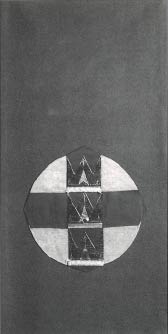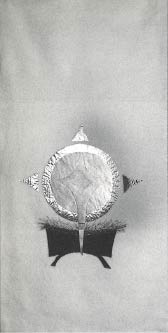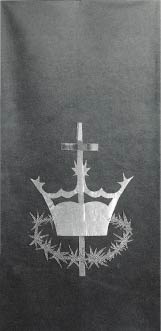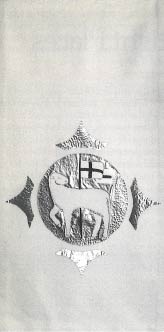Since many congregations are still new to observing the Christian Year, a teaching service about the various church seasons can be very instructive The following service was first conducted at the Neland Avenue Christian Reformed Church in Grand Rapids, Michigan.
Although hymns are suggested in the service, feel free to substitute other seasonal hymns Also, whether you use more or less choir participation will depend on your local situation.
You'll find a brief introduction to the service and a meditation for each part of the church year following the service outline. Again the worship leader should feel free to use and adapt this material for his or her own congregation.
One of the most appreciated parts of the service, especially for children, was the visual "changing" of the seasons. At the beginning of every section of the service, we hung a different parament that illustrated that portion of the Christian Year with appropriate colors and symbols. I also wore a different stole for each season as we "traveled" through the year. Many churches have a series of seasonal banners or paraments that one or two people could help change during the service.
The banners pictured in this service were designed by Edgar Boeve, professor of art, emeritus, at Calvin College in Grand Rapids, Michigan. These banners are a regular part of worship in the Calvin College Chapel.
CELEBRATING THE CHRISTIAN YEAR
In this service we will explain and celebrate the high points of our salvation and of our worship by a review of "The Christian Year." We will listen to the Christmas story and sing Easter songs as we "walk through" the story of Christ's love and our redemption.
Mutual Call to Worship
Rejoice, for God has sent the Messiah—
To bind up the brokenhearted,
to proclaim liberty to the captives,
to grant to those who mourn
a garland instead of ashes,
the mantle of praise, instead of a faint spirit.
Arise, shine, for our light has come.
Greeting from God
Greeting Each Other
Hymn: "All Hail the Power of Jesus' Name" Perronet
Introduction
ADVENT
Scripture: Isaiah 2:1–5
Meditation: Anticipating Christ's Coming: A Time Warp
Hymn: "Lo, How a Rose E'er Blooming" 15th cent. German hymn
st. 1: choir
st. 2–3: congregation
CHRISTMAS
Scripture: Luke 1:46–55; Luke 2:1–7
Meditation: Celebrating Christ's Coming: An Upside-Down World
Choir: "That Boy-Child of Mary" Colvin
EPIPHANY
Meditation: Christ, the Light of the World
An Epiphany Litany
The magi came from faraway places, following a star.
We come to worship, and the star gives us light.
The magi brought gifts of gold, frankincense, and myrrh to offer the Child.
We too bring gifts—ourselves, our hopes, our dreams.
In this visit Christ was revealed to all the world.
We will show the light of Christ to people close by and far away.
The story continues. The good news abounds.
There is a living Christ to discover and worship and serve.
Let us rejoice and be glad!
Hymn: "The King of Glory Comes" Jabusch
st. 1: choir
st. 3–4: congregation
LENT
Meditation: Christ's Suffering; Our Spiritual Discipline
Prayer of Confession and Dedication
Hymn: "What Wondrous Love Is This" Anonymous
st. 1: choir
st. 3–4: congregation
EASTER
Scripture: 1 Corinthians 15:12–14; 20–28
Meditation: Christ—Risen and Victorious
Hymn: "Oh, How Good Is Christ the Lord"
PENTECOST
Scripture: Acts 2:1–4; 14–21; 42–47
Meditation: Christ's Spirit in the Church
Hymn: "Oh, for a Thousand Tongues" Wesley
Blessing: "Go Now in Peace" Sleeth
MEDITATIONS FOR THE SERVICE
Introduction
Since we are about to begin a new church year, what we'll do this evening is walk through the Christian Year together in a teaching-worship service. In doing so we will remind each other of the highlights of our faith as celebrated in our worship.
Just as the Hebrew people had an annual cycle of feasts (such as Passover) to remind them of God's acts of redemption, so we can join together in remembering God's acts of salvation through the Christian Year.
ADVENT
Anticipating Christ's Coming: A Time Warp

"Advent," as you know, means "coming." And the kinds of comings we remember during these four weeks span the centuries—all the way from the old Jerusalem to the new Jerusalem.
First, the reading from Isaiah. It talks about Israel and Assyria. About Eastern empires and empirettes. About local Desert Shield campaigns with swords and chariots. About relief from the dreariness of Israel's town-hall corruption. Isaiah comes with a promise for his people—a promise of peace and light, of a mountain retreat, of a toddler playing with poisonous snakes. That promise was like refreshing spring showers in the desert.
But Isaiah's words do more. Just as a satellite in the sky can transcend limitations of geography and time zones, so Isaiah's message can bounce through time and space. The voice of promise lifts the blue funk of Isaiah and Uzziah. But it also lifts the spirits of Elizabeth and Mary, Zachariah and Joseph. Or, to pick up on Isaiah's favorite light image—the light brightens up the smudgy corners of his Judah people—relief is on the way. But it also shines through the mist of history; that murky distance (which we now call "New Testament" time) will also be lit up like an out-of-time Christmas tree.
There's more. The megaphone of Isaiah's voice travels still further Skipping over yet more centuries, it gets right to the edge of time, to the very borders of Narnia. "In the days to come…in the last days" Isaiah's voice will be heard again as we see the final beating of swords and Stealth bombers into plows and combines. And that light will shine to a new Jerusalem— to a New Heaven and New Earth. Then Mary's little lamb and the lion will nuzzle each other, and God's people from Baghdad and Washington will pick leaves for the healing of the nations—together.
From Assyria and Jerusalem to Bethlehem, from Bethlehem to New Jerusalem—Isaiah involves us in space travel and time warp. Our calendars and atlases are out of whack, and we go back to the future and back again.
But there's still more—Christ is coming to our town too. One of Advent's comings is to our lives in 1994. So we have to make time and space for him—or better yet, he will fill our time and space.
In our yearly Advent celebration we try to capture some of that time warp. For example, we sing, putting ourselves in the sandals of God's Old Testament people, "O Come, O Come, Immanuel"—knowing full well that he has come already. We have the pregnancy of a virgin to prove it.
And next we put on terry-cloth bathrobes to look like no shepherd probably ever looked, and one of our kids says, "I am the Star of Bethlehem." In some strange, timeless way we do stumble over the boulders and wagon ruts of the fields of Bethlehem, get to the stable, and hear Mary say, "It's a boy!"
CHRISTMAS
Celebrating Christ's Coming: An Upside-Down World

Christmas is a crib, the little baby Jesus, Mary, Joseph, angels, shepherds, cows, lights, gifts, cantatas, poinsettias.
Christmas is also a world turned upside down. Mary told us so. Those whom Jesus later calls "the meek" are the same as those Mary calls "the humble"—and they are to be lifted up.
You don't have to know much history or watch much current news to find out that this idea of the meek and the humble being lifted up—that is, in control—does not seem very true to life. After all, right at the beginning of history Cain was the stronger. He beat Abel to death, and that seemed to set the pattern for the rest of human history. The ones with the strongest muscles, heaviest clubs, most gunpowder, and biggest tanks have had the power to control the meek, the humble, the hungry. From Roman Christians to Native Americans to Chinese freedom seekers at Tiananmen Square to Croatian minorities—the force of brute power has conquered. The strong have destroyed people's bodies, spirits, dignity, and religion.
Yes, says Mary's song, but a time is coming (has come) when this history will be turned upside down. God, she says, is the Mighty One. God does mighty deeds with his arms, he scatters those who are proud, he brings down rulers, he sends away the rich. As Jesus later said, the first shall be last. The brute power of tanks, or the subtle power of education or money (if used to take advantage of others), will be broken. That's what this song says.
Is that really so? Will that happen only in some never-never land or will we see it in this life? I think we do see it from time to time.
From the sixties I remember a black, pigtailed girl from a Baptist home in Mississippi wanting to be in a good school. I remember her walking with grace and dignity through two walls of hate-filled, spitting, obscenity-yelling people. Her faith and courage achieved a victory over two hundred years of discrimination and hatred. That was an upside-down victory for the meek.
And remember Corrie ten Boom of The Hiding Place? Her courage and faith triumphed over the brute power of a Nazi concentration camp. That was an upside-down victory for the meek too.
When we hear stories like those, we begin to see a vision—a vision of an upside-down world in which hungry people in Somalia and County will be filled, disadvantaged people in our cities will be given justice and education, unborn children will not be aborted but will be born, and persecuted peoples will have freedom of religion. The power of evil and oppression will be turned upside down.
EPIPHANY
Christ, the Light of the World

"Epiphany" as the Greek and Latin scholars among us would be glad to tell us, means "manifestation" or "showing forth." Manifestation of what? Of Jesus to the wise men, the magi, the kings.
Is that worth a separate remembering? Perhaps. At least allowing the wise men to come to Bethlehem on January 6, twelve days after Christmas, is a bit closer to the biblical story On our typical Christmas pageant stage we usually gather the magi along with the shepherds, the cows, the crib, Joseph and Mary, and the baby That gets very crowded—and it's not very true to the biblical record. According to Matthew the wise men did not join the shepherds in the Bethlehem maternity ward. They came many months later. So, a separate feast remembering the wise men may be appropriate.
But there's another reason for giving the magi their day in the Christian calendar. With their visit we get the first inkling of a new vision, the first tremor of a spiritual earthquake.
What's new here? Well, the Jews liked to talk about our kind of people, our temple, our synagogue, our God. They shunned other people as outsiders. With the arrival of the magi, the shell of insiders and outsiders begins to crack. The outsiders are starting to come in. Maybe the Jews said, "Watch out, the magi are coming! Those strange people with their new ways and new songs are coming."
That's what Epiphany is all about. God's story, Jesus' light is coming—not just for Hebrews, not just for insiders, but for all people. And lucky for us. Very few of us here are of Jewish blood. Jesus' light came to include our great, great, great-grandparents—and us. Yes, we bask in that light for all people, that love of Jesus for all.
But Epiphany is also a reminder to us that we sometimes find it just as hard as the Jews to enlarge our circle. We find it more comfortable to be with our own kind (American, Canadian, Dutch, Korean, Spanish). We prefer our own songs, our own customs, and we sometimes look down our ethnic noses at others with a sense of blood or spirit superiority.
So Epiphany is a double reminder: first, it's a glorious retelling of the light of God's love for all people, for all languages; second, it's a feast that nudges and pushes us with the reminder, "Remember, 'our people' means all God's people."
LENT
Christ's Suffering; Our Spiritual Discipline

We don't have to worry too much that Hallmark and Wal-Mart are going to take over Tent. We're not going to hear shopping-mall jingles to "O Sacred Head, Now Wounded." Tent is too close to reality. It deals with unmentionables like sin, depravity, evil.
In Lent we come to the nub of the Christian story. We are in a mess, and we can't get ourselves out of it. No amount of North American self-help, no spiritual Reaganomics of pulling yourselves up by your own bootstraps is going to work here. Tent reminds us of Jesus' suffering for our sin, the basic story of our selfish hearts and lives needing to be redeemed by God's hurting love. The cheerful news of an awful death. The death rattle on a Friday that we call good. Yes, for six weeks in our Christian calendar we are reminded of the bad-news/good-news story focused in the passion and death of Christ.
And what about the giving up of sweets? Is that just a frivolous gesture to keep us out of the dentist's chair? Perhaps. But there also may be a deeper truth in the sometimes frivolous, "What are you giving up for Lent?"
The deeper truth is that Jesus' death is not just something that happened back then, out there. No, it's an event that must affect our lives. That infinitely expensive grace—even though it's free—comes into our lives and is going to make a difference. During Tent we ask, "Were you there when they crucified my Lord?" "Yes, I was. That double-crossing I did last week, that fit of anger this morning…yes, I was there. Please forgive me, Lord."
Lent is a time of coming to terms not just with human sin, but also with my sin; not just with evil in the world, but also with my selfishness that may contribute to poverty on skid row. That's part of Lent. And prayer and fasting may help me to come to an honest self-examination.
But Lent goes beyond introspection. Lent also means renewal. As I am reminded of Christ's saving me, rescuing me from myself, I also say to myself, "That old Adam, that old Eve, that old Harry—that's not really me anymore. Through the divine magic of grace there's now a new me—the real me. And I am going to live like that new me."
Maybe I'm giving up candy—but, more important, I'm giving up gossip. Maybe I'm giving up meat—but, more importantly, I'm going to volunteer to work in Appalachia next summer. The darkness of Lent shows the morning of new birth, new life, new relationships.
That's worth concentrating on—taking Christ's love to ourselves and making it ours. And, of course, that's not really limited to these six weeks of Lent. It's as true in September as it is in March. That story and that life change—which we are reminded of every year—becomes our lifestyle year round.
EASTER
Christ—Risen and Victorious

Easter is the Christian Independence Day celebration. It's a day for processions, trumpets, and hallelujahs. It's the morning after the dark of night, victory after defeat, life after death, rising after going into the pit, heaven after hell.
How do we celebrate it? Some churches have an all-night vigil, starting on Saturday evening and spending the night in meditation, Scripture reading, song, and prayer. Those of us who can't keep awake past 11:30 may be brave and gather for a 6:00 sunrise service. Those are good traditions.
The church also has a good tradition of extending Easter into an Easter season. The seven weeks after Easter, called the Fifty Great Days, are a wonderful way to treasure, to savor this victory of Christ, the triumph of life over death—to let it seep into our hearts and minds and lives. Christ really did conquer death and hell. And therefore we can be conquerors over our private hells and temptations and evils. We can live victorious lives. That's worth celebrating for fifty great days.
This victory is punctuated by a celebration that is nearly forgotten among us: the Ascension, the glorious homecoming of Christ, to be seated at the right hand of the Father. Again we say, "Hallelujah, what a Savior."
PENTECOST
Christ's Spirit in the Church

Pentecost is the conclusion of Easter—the graduation after senior-year finals. Jesus rose, he ascended, and he now sends his Spirit. Being zapped with the Spirit puts the church on fire. The signs of the Spirit are tongues of fire dancing on people's heads, the noise of a tornado, and people speaking in strange languages. That Spirit means business. And part of that business is preaching, prophesying, repentance, baptism, worship, sharing homes and meals. All those exciting things take place on that historic day—that day of the Spirit—celebrated in flaming red.
And then there's that long time after Pentecost—called the season after Pentecost or Ordinary Time—about twenty-five ordinary Sundays. No royal births, no magi and frankincense, no Palm Sunday procession, no resurrection—just ordinary Sundays. What do we do with those days?
We remind each other of powerful results. Here God's people show that the birth of Jesus, the power of his resurrection, and being zapped by the Spirit have changed and transformed us. The green can stand for life and growth, and we demonstrate that life in our activity. As a church we are busy with personal spiritual growth and Bible study, with evangelism and mission, with walks for hunger relief and providing housing for the homeless. That's the kind of church that we are always in the process of becoming—presenting ourselves, as Paul says, as living sacrifices.
And, finally, a word about destination. Even though we can walk through the Christian Year every year, being reminded, on a regular basis, of the great truths of redemption, we shouldn't really think of it as a cycle. It's more like a winding staircase with a destination, a goal. We're walking toward a reunion, to a glorious meeting with Christ, to a new heaven and new earth. Every year we walk the Christian Year we are one year closer to that return of Christ and our being with him. "Come quickly, Lord Jesus!"

